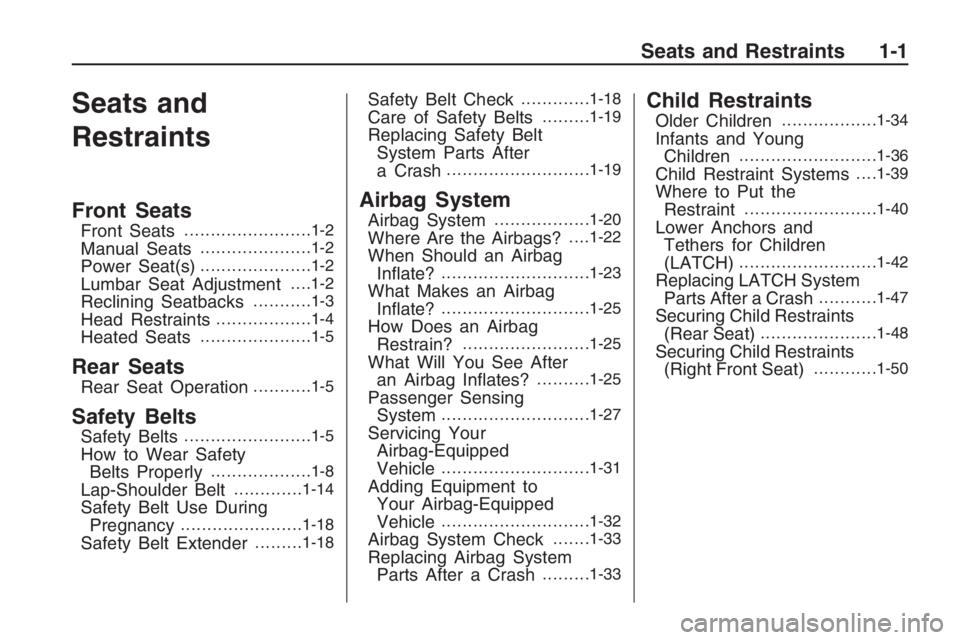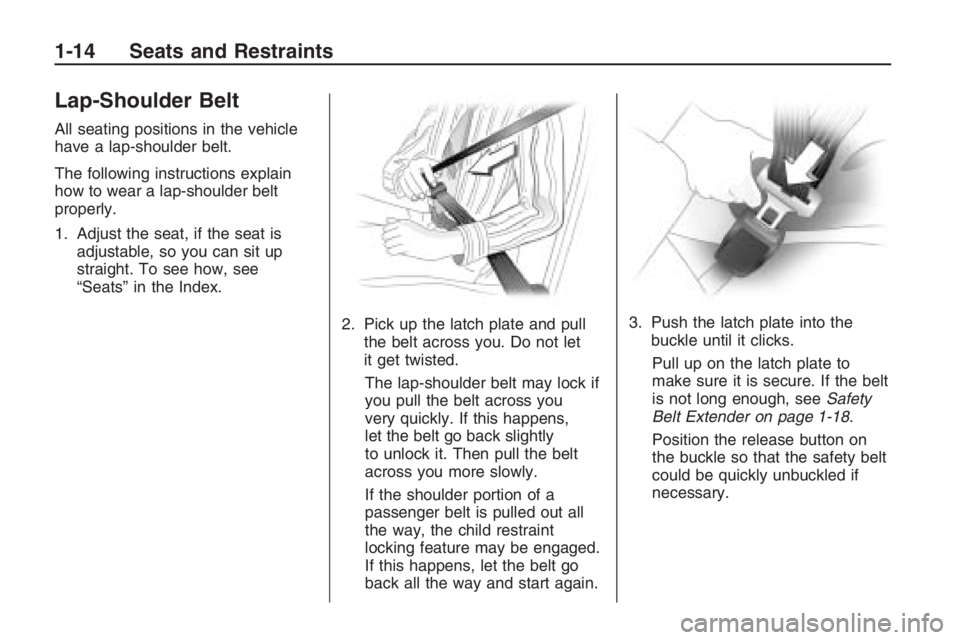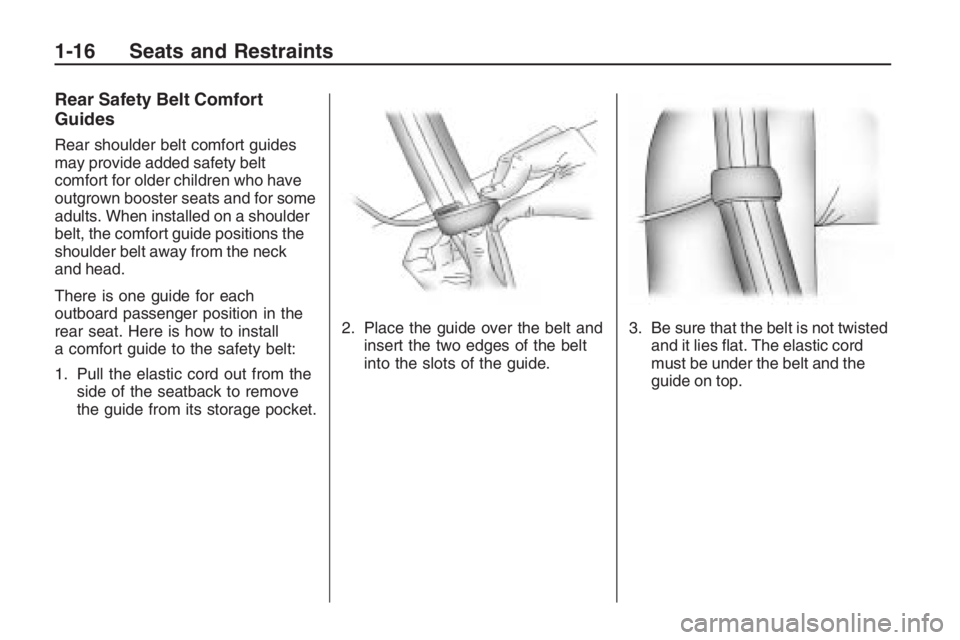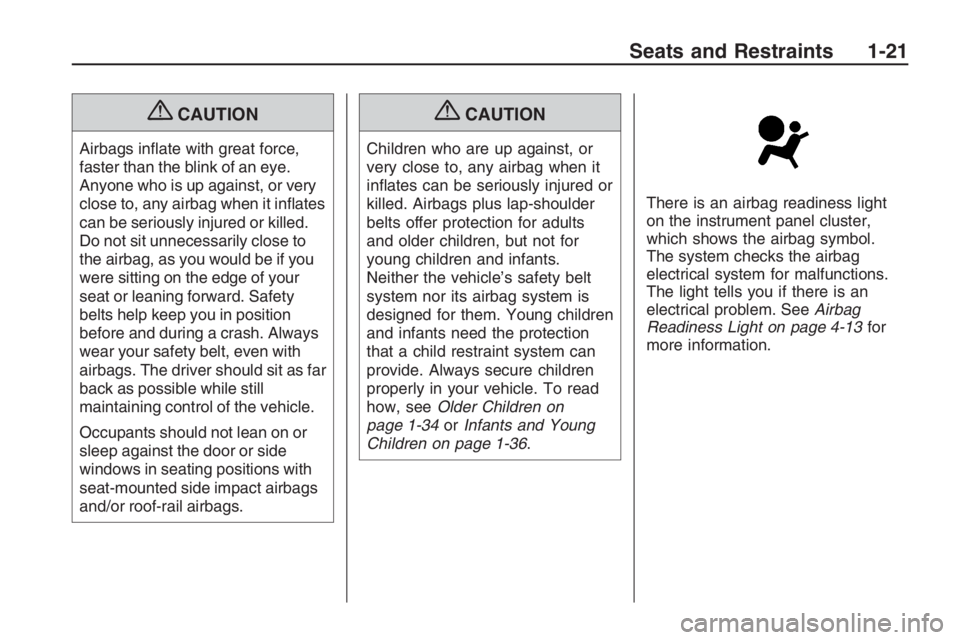2009 PONTIAC G8 child seat
[x] Cancel search: child seatPage 1 of 356

Seats and Restraints......... 1-1
Front Seats
.................... 1-2
Rear Seats
.................... 1-5
Safety Belts
................... 1-5
Airbag System
..............1-20
Child Restraints
.............1-34
Keys, Doors and
Windows............................ 2-1
Keys
............................. 2-2
Doors and Locks
............ 2-8
Theft-Deterrent
Systems
...................2-11
Windows
......................2-14
Mirrors
.........................2-16
Sunroof
........................2-18
Storage.............................. 3-1
Storage
......................... 3-1
Instruments and
Controls............................. 4-1
Instrument Panel
Overview
.................... 4-2
Warning Lights, Gages, and
Indicators
..................4-10Driver Information
Center (DIC)
.............4-22
OnStar
®System
............4-35
Lighting............................. 5-1
Lighting
......................... 5-1
Infotainment...................... 6-1
Audio System(s)
............. 6-1
Climate Controls............... 7-1
Climate Controls
............. 7-1
Driving and Operating....... 8-1
Starting and Operating
Your Vehicle
............... 8-2
Driving Your Vehicle
......8-16
Fuel
............................8-34
Vehicle Service
and Care............................ 9-1
Service
.......................... 9-2
Owner Checks
................ 9-5
Headlamp Aiming
..........9-28
Bulb Replacement
.........9-31
Electrical System
...........9-36
Tires
...........................9-42Tire Changing
...............9-66
Jump Starting
...............9-84
Towing
........................9-88
Appearance Care
..........9-95
Technical Data.................10-1
Vehicle Identi�cation
......10-1
Capacities and
Speci�cations
............10-2
Service and
Maintenance.....................11-1
Service and
Maintenance
..............11-1
Customer Information......12-1
Customer Information
.....12-1
Reporting Safety
Defects
...................12-14
Vehicle Data Recording
and Privacy
.............12-16
Index....................................i-1
2009 Pontiac G8 Owner ManualM
Page 5 of 356

Seats and
Restraints
Front Seats
Front Seats........................1-2
Manual Seats.....................1-2
Power Seat(s).....................1-2
Lumbar Seat Adjustment. . . .1-2
Reclining Seatbacks...........1-3
Head Restraints..................1-4
Heated Seats.....................1-5
Rear Seats
Rear Seat Operation...........1-5
Safety Belts
Safety Belts........................1-5
How to Wear Safety
Belts Properly...................1-8
Lap-Shoulder Belt.............1-14
Safety Belt Use During
Pregnancy.......................1-18
Safety Belt Extender.........1-18
Safety Belt Check.............1-18
Care of Safety Belts.........1-19
Replacing Safety Belt
System Parts After
a Crash
...........................1-19
Airbag System
Airbag System..................1-20
Where Are the Airbags?. . . .1-22
When Should an Airbag
In�ate?............................1-23
What Makes an Airbag
In�ate?............................1-25
How Does an Airbag
Restrain?........................1-25
What Will You See After
an Airbag In�ates?..........1-25
Passenger Sensing
System............................1-27
Servicing Your
Airbag-Equipped
Vehicle
............................1-31
Adding Equipment to
Your Airbag-Equipped
Vehicle
............................1-32
Airbag System Check.......1-33
Replacing Airbag System
Parts After a Crash.........1-33
Child Restraints
Older Children..................1-34
Infants and Young
Children..........................1-36
Child Restraint Systems. . . .1-39
Where to Put the
Restraint.........................1-40
Lower Anchors and
Tethers for Children
(LATCH)
..........................1-42
Replacing LATCH System
Parts After a Crash...........1-47
Securing Child Restraints
(Rear Seat)......................1-48
Securing Child Restraints
(Right Front Seat)............1-50
Seats and Restraints 1-1
Page 12 of 356

Questions and Answers About
Safety Belts
Q:
Will I be trapped in the vehicle
after a crash if I am wearing a
safety belt?
A:Youcouldbe — whether you are
wearing a safety belt or not. But
your chance of being conscious
during and after an accident, so
youcanunbuckle and get out, is
muchgreater if you are belted.
And you can unbuckle a safety
belt, even if you are upside down.
Q:If my vehicle has airbags,
why should I have to wear
safety belts?
A:Airbags are supplemental
systems only; so they workwith
safety belts — not instead of
them. Whether or not an airbag is
provided, all occupants still have
to buckle up to get the most
protection. That is true not only in
frontal collisions, but especially in
side and other collisions.
Q:If I am a good driver, and I
never drive far from home,
why should I wear safety
belts?
A:You may be an excellent driver,
but if you are in a crash — even
one that is not your fault — you
and your passenger(s) can be
hurt. Being a good driver does not
protect you from things beyond
your control, such as bad drivers.
Most accidents occur within
25 miles (40 km) of home. And
the greatest number of serious
injuries and deaths occur at
speeds of less than 40 mph
(65 km/h).
Safety belts are for everyone.
How to Wear Safety Belts
Properly
This section is only for people of
adult size.
Be aware that there are special
things to know about safety
belts and children. And there are
different rules for smaller children
and infants. If a child will be riding in
the vehicle, seeOlder Children on
page 1-34orInfants and Young
Children on page 1-36. Follow those
rules for everyone’s protection.
It is very important for all occupants
to buckle up. Statistics show that
unbelted people are hurt more often
in crashes than those who are
wearing safety belts.
Occupants who are not buckled up
can be thrown out of the vehicle
in a crash. And they can strike
others in the vehicle who are
wearing safety belts.
1-8 Seats and Restraints
Page 18 of 356

Lap-Shoulder Belt
All seating positions in the vehicle
have a lap-shoulder belt.
The following instructions explain
how to wear a lap-shoulder belt
properly.
1. Adjust the seat, if the seat is
adjustable, so you can sit up
straight. To see how, see
“Seats” in the Index.
2. Pick up the latch plate and pull
the belt across you. Do not let
it get twisted.
The lap-shoulder belt may lock if
you pull the belt across you
very quickly. If this happens,
let the belt go back slightly
to unlock it. Then pull the belt
across you more slowly.
If the shoulder portion of a
passenger belt is pulled out all
the way, the child restraint
locking feature may be engaged.
If this happens, let the belt go
back all the way and start again.3. Push the latch plate into the
buckle until it clicks.
Pull up on the latch plate to
make sure it is secure. If the belt
is not long enough, seeSafety
Belt Extender on page 1-18.
Position the release button on
the buckle so that the safety belt
could be quickly unbuckled if
necessary.
1-14 Seats and Restraints
Page 20 of 356

Rear Safety Belt Comfort
Guides
Rear shoulder belt comfort guides
may provide added safety belt
comfort for older children who have
outgrown booster seats and for some
adults. When installed on a shoulder
belt, the comfort guide positions the
shoulder belt away from the neck
and head.
There is one guide for each
outboard passenger position in the
rear seat. Here is how to install
a comfort guide to the safety belt:
1. Pull the elastic cord out from the
side of the seatback to remove
the guide from its storage pocket.2. Place the guide over the belt and
insert the two edges of the belt
into the slots of the guide.3. Be sure that the belt is not twisted
and it lies �at. The elastic cord
must be under the belt and the
guide on top.
1-16 Seats and Restraints
Page 22 of 356

Safety Belt Use During
Pregnancy
Safety belts work for everyone,
including pregnant women. Like all
occupants, they are more likely
to be seriously injured if they do not
wear safety belts.
A pregnant woman should wear a
lap-shoulder belt, and the lap portion
should be worn as low as possible,
below the rounding, throughout
the pregnancy.The best way to protect the fetus is
to protect the mother. When a safety
belt is worn properly, it is more likely
that the fetus will not be hurt in a
crash. For pregnant women, as for
anyone, the key to making safety
belts effective is wearing them
properly.
Safety Belt Extender
If the safety belt will fasten around
you, you should use it.
But if a safety belt is not long
enough, your dealer/retailer will order
you an extender. When you go in to
order it, take the heaviest coat you
will wear, so the extender will be long
enough for you. To help avoid
personal injury, do not let someone
else use it, and use it only for the
seat it is made to �t. The extender
has been designed for adults.
Never use it for securing child seats.
To wear it, attach it to the regular
safety belt. For more information,
see the instruction sheet that comes
with the extender.
Safety Belt Check
Now and then, check the safety belt
reminder light, safety belts, buckles,
latch plates, retractors and
anchorages are working properly.
Look for any other loose or damaged
safety belt system parts that might
keep a safety belt system from doing
its job. See your dealer/retailer to
have it repaired. Torn or frayed
safety belts may not protect you in a
crash. They can rip apart under
impact forces. If a belt is torn or
frayed, get a new one right away.
Make sure the safety belt reminder
light is working. SeeSafety Belt
Reminders on page 4-12for more
information.
Keep safety belts clean and dry.
SeeCare of Safety Belts on
page 1-19.
1-18 Seats and Restraints
Page 25 of 356

{CAUTION
Airbags in�ate with great force,
faster than the blink of an eye.
Anyone who is up against, or very
close to, any airbag when it in�ates
can be seriously injured or killed.
Do not sit unnecessarily close to
the airbag, as you would be if you
were sitting on the edge of your
seat or leaning forward. Safety
belts help keep you in position
before and during a crash. Always
wear your safety belt, even with
airbags. The driver should sit as far
back as possible while still
maintaining control of the vehicle.
Occupants should not lean on or
sleep against the door or side
windows in seating positions with
seat-mounted side impact airbags
and/or roof-rail airbags.
{CAUTION
Children who are up against, or
very close to, any airbag when it
in�ates can be seriously injured or
killed. Airbags plus lap-shoulder
belts offer protection for adults
and older children, but not for
young children and infants.
Neither the vehicle’s safety belt
system nor its airbag system is
designed for them. Young children
and infants need the protection
that a child restraint system can
provide. Always secure children
properly in your vehicle. To read
how, seeOlder Children on
page 1-34orInfants and Young
Children on page 1-36.There is an airbag readiness light
on the instrument panel cluster,
which shows the airbag symbol.
The system checks the airbag
electrical system for malfunctions.
The light tells you if there is an
electrical problem. SeeAirbag
Readiness Light on page 4-13for
more information.
Seats and Restraints 1-21
Page 31 of 356

Passenger Sensing
System
The vehicle has a passenger
sensing system for the right front
passenger position. The passenger
airbag status indicator will be
visible in the rearview mirror when
the vehicle is started.The words ON and OFF, or the
symbol for on and off, will be visible
during the system check. If you
are using remote start to start the
vehicle from a distance, if equipped,
you may not see the system
check. When the system check is
complete, either the word ON
or OFF, or the symbol for on or off,
will be visible. SeePassenger
Airbag Status Indicator on
page 4-14.
The passenger sensing system will
turn off the right front passenger
frontal airbag under certain
conditions. The driver airbags are
not affected by the passenger
sensing system.The passenger sensing system
works with sensors that are part of
the right front passenger seat. The
sensors are designed to detect the
presence of a properly-seated
occupant and determine if the right
front passenger frontal airbag should
be enabled (may in�ate) or not.
Accident statistics show that children
are safer if they are restrained in
the rear rather than the front seat.
We recommend that children
be secured in a rear seat, including:
an infant or a child riding in a
rear-facing child restraint; a child
riding in a forward-facing child seat;
an older child riding in a booster
seat; and children, who are
large enough, using safety belts. United States
Canada
Seats and Restraints 1-27